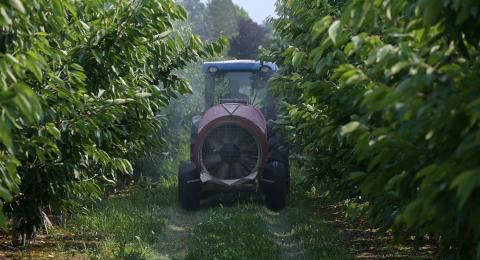Optimizing your air blast sprayerʼs distribution pattern is a key part of controlling pests on fruit and vegetable crops. This fact sheet outlines four methods for examining and optimizing spray patterns.
Before You Start
Calibrating your sprayer is the first step. Before evaluating and adjusting spray distribution, calibrate your sprayer so you know you are applying the correct amount of material. Follow the steps in the Air Blast Sprayer Calibration worksheet.
Set Up Your Sprayer
Check your sprayer and all its components to be sure it is set up correctly. Make sure that:
- The pressure is correct
- Nozzles are set at the correct height for your crop
- Distances between nozzles are correct
- Nozzles are not plugged
Test your sprayer using the same settings that you will use when treating crops. The sprayer should be at the same speed (RPM, gear and throttle
setting) that you will use later. Put water in the sprayer tank when testing.
Spray Pattern Options
There are four different methods that can be used to examine and optimize the spray pattern:
- Measuring Devices
This method requires the sprayer to be stationary. Attach a hose to each nozzle. Direct each hose into a graduated cylinder or other marked measuring device. Make sure the hoses are secure and do not leak. Turn on the sprayer and run it for a standard amount of time (30 seconds, for example). Record how much spray was collected from each nozzle. Calculate the total output by adding up the results from all nozzles.
Note: For spraying orchards, you may want different amounts of material coming out of each nozzle to match canopy distribution. - Water Sensitive Cards
These one-use cards are available from some pesticide suppliers and many spray equipment dealers. They are yellow and turn blue wherever a drop of water or oil touches them. To test, set up a series of cards on the crop you intend to spray. Clothespins can be used to clip cards to plants. For an orchard, set cards at the top of the canopy (on a pole, for example) in the interior, and low in the canopy. For a mist blower on sweet corn, place cards in different rows as far away as you want to cover with one swatch. Mark the position on each card with a pen. Run the sprayer once by the row or block. Retrieve the cards. The blue dots will show your sprayerʼs coverage. If necessary, you can replace the used cards with new cards, adjust your sprayer settings, and perform a second test. - Kaolin-based Sprays or Dyes
Instead of water, put a food-grade kaolin-based spray (like Surround) or UV dye in the sprayer tank. Spray your test plants using the same settings you would use as normal. You may have to wait a few minutes for the material to dry before seeing results. This quick method often makes it easy to see gaps and overlaps in coverage. It does not allow for immediate comparisons as you adjust settings, however. The testing materials will often wash off with the rain. - Patternators
This specialized equipment provides an accurate method for checking two-dimensional spray distribution. Equipment availability may be limited and an experienced technician is required for set up. Several passes with a patternator will help determine how much material is reaching different coverage heights.
Recording Your Results
Maintaining accurate records is essential to the optimization process. Once you have adjusted your sprayer to the correct pattern, write down the settings (along with the date and time of testing) so that you can use the optimized settings in the future. This is especially helpful if your sprayer is repaired or modified.
Visit https://sprayers101.com/ for more information on assessing spray coverage.
The information in this document has been funded wholly or in part by the US EPA Region 1 to the New England Vegetable & Berry Growers’ Association; it may not necessarily reflect the views of the Agency and no official endorsement should be inferred. Mention of trade names or commercial products does not constitute endorsement or recommendation of use.
Additional Resources
- Air Blast Sprayer Calibration Worksheet
- Boom Sprayers - 1/128th Method of Calibration
- Boom Sprayers - One-Minute Method of Calibration
- Quick Tips and More Guidance For Using Your Sprayer [videos]
About the Author
George Hamilton is a retired UNH Cooperative Extension Field Specialist in agriculture dealing with fruit and vegetable production.
ACKNOWLEDGEMENTS
Thank you to Dr. Jason Deveau, Application Technology Specialist, OMAFRA, Simcoe, Ontario and Dr. Alan T. Eaton, retired Extension Specialist in Entomology and professor, emertius at the University of New Hampshire, for reviewing the original manuscript.
UNH EXTENSION'S FOOD AND AGRICULTURE PROGRAM
As a component of Extension's Food & Agriculture Program, UNH Extension provides educational resources, training programs, and direct technical assistance for private and commercial pesticide applicators.
Extension Services & Tools That Help NH Farmers Grow
Newsletters: Choose from our many newsletters for production agriculture
Receive Pest Text Alerts - Text UNHIPM to (866) 645-7010


